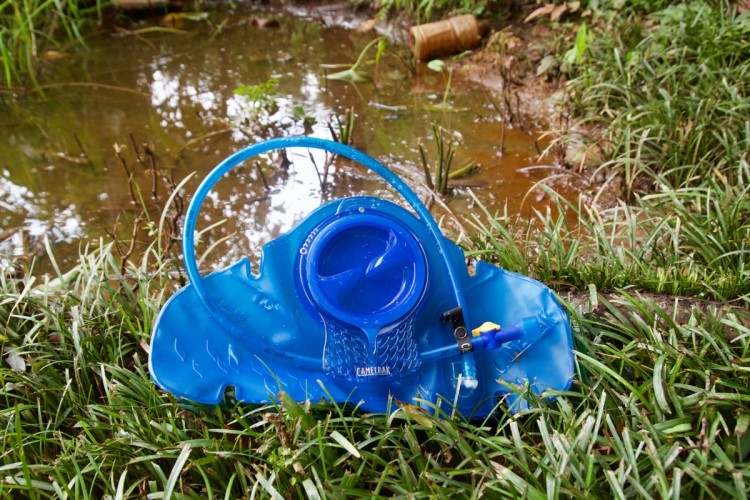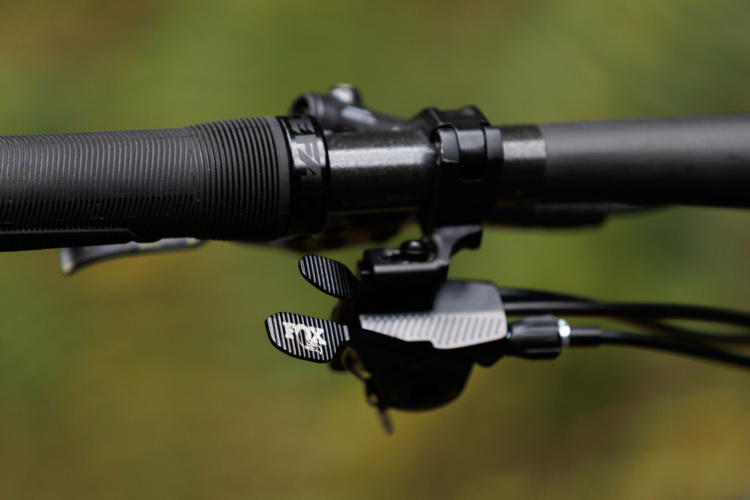What is a pump track?
In this article I will explain the basic techniques required for riding a pump track. But when I say “pump track,” there are probably a number of people that have no idea what I’m talking about.
A pump track is a continuous circuit of dirt rollers, berms, and jumps that loops back on itself, allowing you to ride it continuously.
Photo right: Me riding the advanced pump track at Big Creek. Photo: Summer H.
Why should I ride a pump track?
Riding a pump track will teach you a number of critical skills that can benefit you in tangible ways out on the singletrack:
- It teaches you how to pump the terrain to gain speed (more on this below).
- It teaches you how to ride berms and improve cornering.
- It teaches you how to maintain momentum in order to ride as fast as possible.
- It helps you learn how to look several steps ahead of where you’re riding.
- It creates a playful bike-handling demeanor, allowing you to see interesting lines on the trail that might not be so obvious.
- It provides an intense full-body workout in a very short amount of time.
- It’s tons of fun!

Part of a pump track.
What kind of bike should I ride?
The ideal bike for a pump track is a dirt jump bike:

Element22’s Banshee Amp DJ Bike.
Dirt jump bikes have 26″ wheels, super short chainstays, aggressive geometry, beefy frames, hardy components, stiff forks, and a super-low seat. They are designed and built with dirt jumping in mind, and pump tracks are a natural spinoff from dual slalom courses and dirt jumps with their berms, doubles, and rhythm sections.
While a DJ bike is the ideal machine, you can sample a pumptrack with just about anything. If you have 26″ wheels and a rear end with no suspension, you’re in pretty good shape: just drop the saddle so you have room to let the bike move under you.
Pump Track 101
As mentioned above, the basic goal of a pump track, besides having fun, is to teach you how to pump the terrain to maintain speed. Pump tracks are set up with a series of rollers and berms that, if the track is designed well and you are riding it correctly, should allow you to gain and maintain your speed through the track without pedaling at all.

Rollers on a pump track.
To do this, as you approach a roller, unweight your front wheel on the front side of the roller. As the wheel crests the top, transfer your weight forward and push down with your arms (and then with your feet) to input power on the downslope. This “pumping” motion (hence the name “pump” track) is what will generate and maintain your speed through the track.

Berm on a pump track.
As you approach a berm, make sure you control your speed into it, then maintain good cornering position through the berm, and try to exit on the other end with more speed than you entered. As you ride the berm, make sure you are looking well through the turn at your exit point, and as you approach the exit, make sure that you continue to look even beyond that.
One of the key ingredients to successful pump track riding (and mountain biking in general) is to maintain a quiet upper body. While the bike will be moving up, down, and sideways beneath you, the goal is to keep your torso, the center of your mass, traveling in as straight of a line as possible as quickly and as fluidly as possible.
Some locations will provide a beginner pump track and an advanced track. No matter what your mountain bike skill level, if you’ve never ridden a pump track before its always a good idea to get the hang of it on the beginner track first. If your local trail only offers an “advanced” track, never fear. The beauty of most pump tracks is that, generally, they can be as easy or as difficult as you make them.
Advanced Techniques
Some sections of a more advanced pump track can be rolled like normal by your average rider, but an advanced rider could possibly do a couple of different things. For instance, look at this feature pictured below:

Advanced feature on a pump track.
It may be hard to tell just from looking at this photo, but this feature can be rolled like normal by an average rider, or an advanced rider could manual over it (riding on just the rear wheel without pedaling). Or, if his speed is high enough and he’s got the rhythm of the track down, he could “double it up” by jumping off the front side of the mound, airing over the flat top section, and landing on the downslope on the back side. Manualing through rollers and gapping certain features with the right rhythm allows experienced riders to gain and maintain significantly more speed on a pump track than your average Joe (like myself).
Video
Want to see how to all works together? Watch Mick Hannah tear up his backyard pump track. It is nowhere near as easy as he makes it look.
Your Turn: Have you ever ridden a pump track?






















19 Comments
Aug 2, 2013
Aug 2, 2013
May 7, 2012
May 2, 2012
May 3, 2012
May 2, 2012
May 2, 2012
May 5, 2012
May 2, 2012
May 6, 2012
After 2-3 trips to the pump track, I noticed a short uphill section on my local trail had natural rollers in them so I pumped my way up the hill and actually gained speed, it was awesome!
May 4, 2012
May 3, 2012
May 31, 2012
May 3, 2012
May 2, 2012
May 3, 2012
May 2, 2012
May 3, 2012
And I totally agree with everyone that said it has significant applications to the trail. Learning to pump the terrain, look ahead of where you are, and maintaining momentum... it's great.
Did I mention how great of a workout pumptracks are too?
May 2, 2012